Handwriting Interpretation
Print and Cursive: What are Print Letters?
Printed letters are those that resemble computer letters or typewriter letters. Their characteristic is that they lack accessory features. They are composed only of the essential parts that make up the skeleton of each letter. They are disconnected, without decorations and without complex parts. They are the first letters that are taught to children during elementary school, first in uppercase and then incorporated in lowercase.
Later on, they are taught the typical calligraphic model of the school cursive, which overtime is left behind to give room to particular traits of each individual. When a child begins writing, he tries to truly copy the model he is taught by the teacher. Due to singularity present in human beings typical and personal traits can be observed.
Italic script is a succession of ascending and descending traits that are connected through angles or garlands that will change according to growth and maturity. The teacher´s mission is to ensure the students´ handwriting keeps legibility, respecting personal style.
Cursive Writing provides great Benefits

We need to point out that cursive writing provides great benefits that we cannot even imagine, which are translated into stimuli for our nervous system.The act of writing is a complex act that combines three areas: Physical-organic through the brain, that articulates the movements of the hand that coordinates the action. The functions like attention, intelligence, concentration, decision or indecision are learned through the execution of the shape of letters. Even though technology moves forward and we need to adjust to that, schools should not stop teaching cursive, transmitting the children the importance of clear and legible expression in their strokes.
Differences between Print and Cursive (Italics Script)
Print letters are a mechanical and neutral adaptation similar to a machine, which turns out to be indifferent and passive.
On the other hand, cursive letters includes strokes that move upwards and downwards and connect with each other through angles and curves and expresses the emotions of the writer and is modified according to states of mind and maturity degrees.
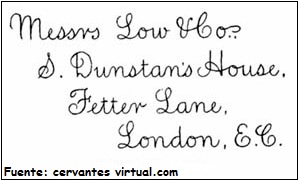
Calligraphic cursive, from a psychological point of view, represents the model to imitate, “what the norm dictates”, the normative aspects of the Superego. It is expected that throughout life, this “perfection” of the model of the calligraphic model becomes simplified and personal and singular. Calligraphy learnt in childhood should evolve according to maturity of the personality.
Legibility
During adolescence, stage at which personality is reinforced and consolidated, it is very common that the young write in print letters. The intention is to be understood and to understand themselves. It is common to hear adolescents say they do not understand what they themselves have written, due to the fact that their handwriting has turned almost illegible. “Legibility” is directly related to mental and affective clarity of each individual. The reason for the use of print is to demonstrate clarity. Sometimes young people are forced to comply with the model that the environment imposes on them. Faced with the impossibility of expressing her desires and her own identity, they restrict her by using printed letters.
Graphology analyzes the clarity of texts through: Order or layout
Read also: Layout: Margins in Graphology.
In other cases, adolescents feel forced to please the model that the environment imposes and before the impossibility of expressing their desire and their own identity they restrict it using print.
What does writing in Print letters Mean?
Using print also reflects personal characteristics of the user. The absence of connecting forms (connected writing) symbolizes difficulty to communicate and to talk about feelings.
Using print is not exclusive to adolescents. It is seen in adults with more frequency. Let us analyze the different variables.
Hiding behind writing in printing letters?
Exempt from interpretation are those professionals who work in advertisement, architecture, IT, and activities that include a technical formation are usually asked to show clarity, a certain degree of esthetics, being print, on occasion, a must. Also, those who sign in print, like in the case of some plastic artists, which is more associated to a fashion that suggests originality, expressing creative ability.
Read Also: Handwriting Analysis Capital Letters
Handwriting Interpretation: Print and Cursive
Psychology and Printing Letters
From the psychological point of view, those who use print reflect that is hard for them to express emotions.They do not allow their feelings to come out spontaneously. They need to have everything under control, avoiding unexpected events. Difference must be made in interpretation according to the “degree” of evolution of each one, since there are different levels.
Print is a regressive type of writing. Its movements do not move. It is static. Traits towards the left or tightness are not necessarily found.
Cursive “progresses”. It moves forward, it projects. Print is “detained”. It stops. Reasons may be the existence of affective blocks, repression of emotions, desire to fight a latent aggression, the need to control the excessive impulsiveness, among others.
Graphology: Interpretation of Lowercase and Capital Print
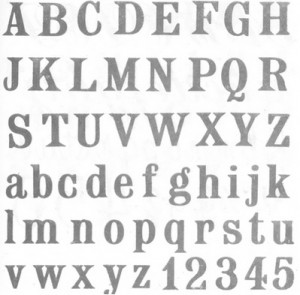
Lowercase print or “SCRIPT”. Let us remember that we do not analyze traits in isolation but that we must consider the graphical environment (positive-negative) of the whole writing and compare with the signature to corroborate the hypothesis. Lowercase or “SCRIPT” is the one that imitates typographic lowercase of the old typewriter or the actual computer. It is still calligraphic and interpreted as disconnected writing. It reflects difficulty in the spontaneous connection with others.
Print Letters and Disconnected Writing
It is a type of writing that responds to a model and presents a great degree of repression of the Ego, since there is a need for filtration of emotions and feelings through reason. Those who use this type of writing present difficulty for expressing their own feelings in words. They repress them and do not allow their feelings to come out spontaneously. This is manifested as a defense or due to distrust and affects relationships with others, which is limited. They need to have everything under control and structured to avoid unexpected events.
Repression is a defense mechanism of the Ego. These defense mechanisms are subconscious strategies that are used to find a balance and avoid suffering. This defense mechanisms are also analyzed in writing.
On the positive side of print, we can find order, precision and clarity in ideas. It denotes that “perfection” prevails before quickness, that there is logical thinking, practical and good ability for concentration. When connections are limited, this symbolizes that self-control and introversion prevail.
When there are no connections, this symbolizes difficulty in adaptation and tendency to isolation. Situations are granted more value to the “form” than to the “matter”, manifesting an exacerbated esthetic sense, sense of order and visual memory (the individual takes the time and makes an effort in letter execution, uses original connections, without losing originality).
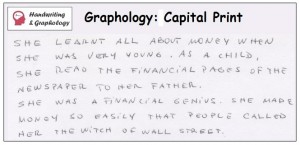
If we analyze this writing from a negative side, we observe that feelings do not flow with spontaneous movements through writing, manifesting the needs, instincts, creativity, but that the individual controls himself, withdraws himself and hides behind the impenetrable automatism and in the habits of conventional rules.
When there is a negative graphical environment confirmed with other traits, there might be lack of transparency, falseness and slyness. People who regularly use print reflect a desire to mask their aspects of personality they hate. They wish to hide personal traits they find unpleasant to cause a better impression in the environment. In order to achieve that, they build an appearance or assign themselves merits and attributes they do not have in order to compensate that inferiority feeling that takes over them. They try to project a perfect impression to defend themselves from the possible rejections, due to shyness, insecurity or to obtain some advantage.
Capital Print
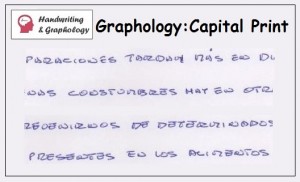
Capital print is typical in titles. It is bigger and less spontaneous for the amount of interruptions that make it a slower type of writing.
Those who use this type of writing are self-controlled individuals, with a lower degree of spontaneity and more conscious. They work very well leading teams, since they like imposing their way of seeing things and they do not tolerate receiving orders. They are very willfull and intelligent. This must be confirmed with other traits like the level of executed pressure, order, conservation of structure of letters and presence of original bonds. The will is expressed in vertical, straight strokes with good pressure.
Read also: Handwriting Analysis: Categories and traits.
On the negative side (we always find positive and negative aspects in each interpretation), these individuals may present limited empathy. Due to their eagerness of domination and desire to stand out they may not in other´s shoes. This may turn them inflexible, with difficulty to adjust to situations.
Capital print is represented only in the middle area. When this form is used, the superior and inferior areas are void, since all letters have the same height. This means that this individual does not “show” himself the way he is. He is censored and hides part of his personality. Self-control and repression levels are so intense that he may explode in violent actions. We need to pay special attention to tension, to the presence of rigidity and predominance of angles in this type of writing.
This is the end of the article Handwriting Interpretation: Print and Cursive writing.
Bibliography: Vels A. “Writing and Personality”, Vels A “Dictionary of Graphology”.

Keep navigating this website to continue discovering Handwriting Analysis Letter “s” and Graphology Definition. Follow us on Facebook!

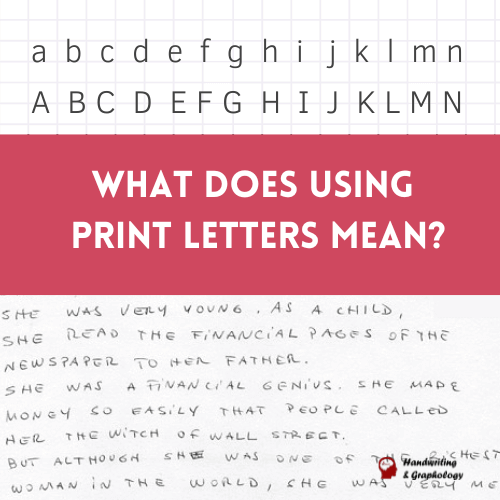
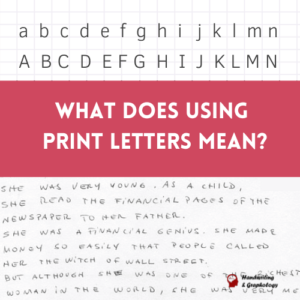
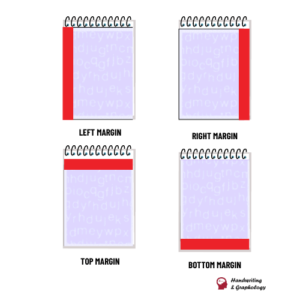
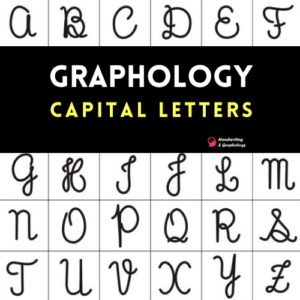
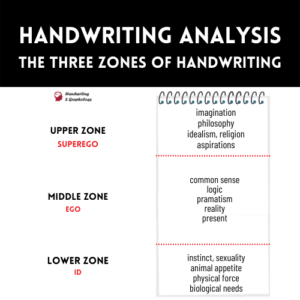

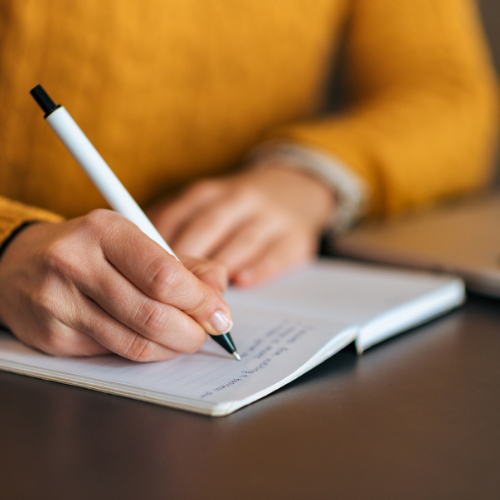
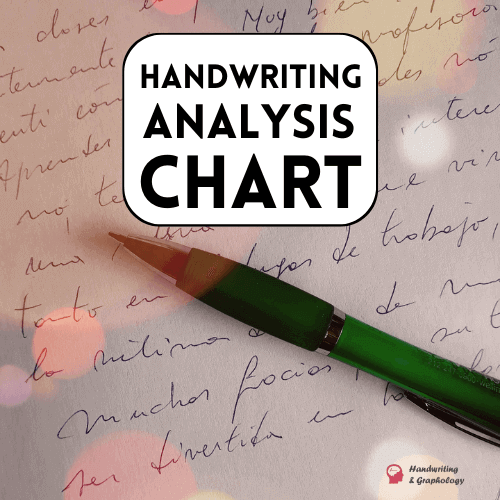
hi
useful information thank you. can i have your mail id please.
I have noticed that everyone who prints is male. Anyone else noticed this? I must be surrounded by these guys!
no, they are not always men, it s just a coincidence
I am a male and I use a combo of cursive and print
I write in all caps sometimes if I’m making a work document. I’m female.
I teach cursive writing at our library and I appreciate the information you provide.
hey this is useful info that I could use but how do you actually know all of this, someone couldn’t just tell a gender or personal traits just by handwriting.
Really? I thought most people could. I could tell the gender of someone by their writing before I knew anything about graphology and I was pretty accurate. I can’t tell you what exactly it was but I could tell.
There is no longer a point to this as the latest generation have no concept of cursive writing because it is no longer taught in schools. For many, the block writing they muddle through is barely legible, mostly due to a lack of use. How does that get interpreted accurately???
Cursive Writing is taught in 28 schools in the United States. These are the latest stats. It is about to be taught in 10 more, as of this report.
Howdy. Am encountering a few personalities who have a great variation in styles. Whether mood changes, artistic impression or disguising of some sort, it is interesting that specific attributes recur in their different style hands. Brain writing for sure. Thanks for the excellent site with your generous commentaries. You are opening the portals to our character. A mirror to see oneself. It only shows the writer and we are invited to the other side of what is seen and not seen. Enter with an open mind.
Hello,
Where I live in Phoenix, Arizona they stopped teaching cursive in school. My youngest daughter, now 21 years old, only knows it because I took it upon myself to teach her by printing my own lessons out.
Is this the case elsewhere in the United States?
Also, how precise can you get with non-cursive graphology?
In CA also. This is a shame. It’s not just that cursive may feel like it’s not used as much, but they forget it teaches kids eye hand control and dexterity.
Unfortunately, cursive is no longer being taught and has not been taught in public schools for quite a while now. So can one interpret anything from another’s “choice” in writing in print when most people do not even know how to write in cursive? In other words, I think the article should be edited to include; because of the decline in the use of cursive writing, when one interprets another’s handwriting, they should know whether the person knows how to write in cursive before making any solid interpretations.
I had a bad head injury and ever since I cant seem to write more then a sentence or two before I swap back and forth with print and cursive, even mixing the two in single words. Is there any way to fight this new instinct?
What about print in a letter. My childs best friend is 17 and lost her mom at a young age. She only has a letter her mom wrote to her in a scrap book. She asked me to analyze it. Are there any tips anyone might have for me? As the reasons behind print vs cursive don’t really apply. Clearly she believed her daughter might read it before she knew cursive.
Thank you for this article, although handwriting is a fading skill. It’s a shame. I haven’t used cursive since the 6th grade. I remember fancying myself my own writing style. This article is so true of my personality. I print all uppercase accept “e”. I don’t know what that says about myself, but the rest is spot on.